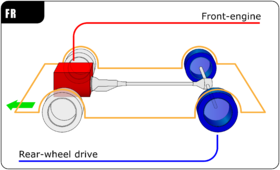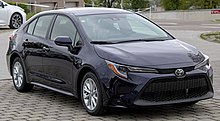This article needs additional citations for verification .(May 2023) |


Front-engine design is an automotive design where the engine is in the front side of the car, connected to the wheels via a drive shaft. [1] The main types of Front engine design are:
- Front-engine, rear-wheel-drive layout, the traditional automotive layout for most of the 20th century.
- Front-engine, front-wheel-drive layout, which became dominant in passenger cars by the late 20th century.
- Front-engine, four-wheel-drive layout.
Advantage of front engine design is better cabin space for passengers, and also bigger boot space. [2] Disadvantage is that more weight of the car goes on front wheels and less weight goes on the rear wheels, that causes understeer. [3]